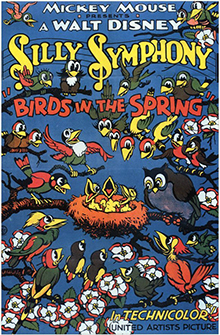
The Wise Little Hen is a 1934 Walt Disney's Silly Symphony cartoon, based on the fable The Little Red Hen. The cartoon features the debut of Donald Duck, dancing to "The Sailor's Hornpipe". Donald and his friend Peter Pig try to avoid work by faking stomach aches until Mrs. Hen teaches them the value of labor.
Silly Symphony is an American animated series of 75 musical short films produced by Walt Disney Productions from 1929 to 1939. As the series name implies, the Silly Symphonies were originally intended as whimsical accompaniments to pieces of music. As such, the films usually did not feature continuing characters, unlike the Mickey Mouse shorts produced by Disney at the same time. The series is notable for its innovation with Technicolor and the multiplane motion picture camera, as well as its introduction of the character Donald Duck making his first appearance in the Silly Symphony cartoon The Wise Little Hen in 1934. Seven shorts won the Academy Award for Best Animated Short Film.
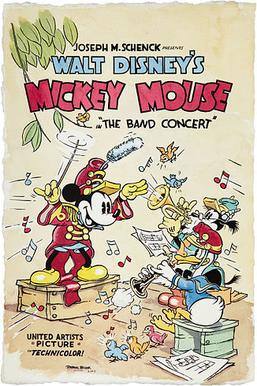
The Band Concert is a 1935 American animated short film produced in 3-strip Technicolor by Walt Disney Productions and released by United Artists. The 73rd short film in the Mickey Mouse series, it was the second release of the year, and notable as the first in the series to be produced in color.
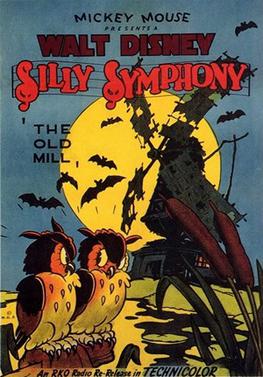
The Old Mill is a Silly Symphonies cartoon produced by Walt Disney Productions, directed by Wilfred Jackson, scored by Leigh Harline, and released theatrically to theatres by RKO Radio Pictures on November 5, 1937. The film depicts the natural community of animals populating an old abandoned windmill in the country, and how they deal with a severe summer thunderstorm that nearly destroys their habitat. It incorporates the song "One Day When We Were Young" from Johann Strauss II's operetta The Gypsy Baron.

Three Little Pigs is a 1933 animated short film released by United Artists, produced by Walt Disney and directed by Burt Gillett. Based on the fable of the same name, the Silly Symphony won the 1934 Academy Award for Best Animated Short Film. The short cost $22,000 and grossed $250,000.
The first wave of Walt Disney Treasures was released on December 4, 2001. It includes four different DVD sets.
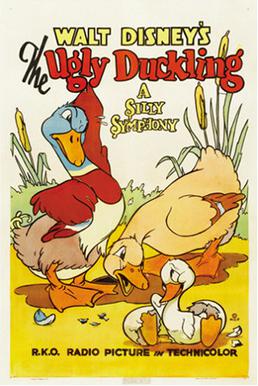
The Ugly Duckling is an animated short film by Walt Disney, based on the 1843 fairy tale "The Ugly Duckling" by Hans Christian Andersen. The film was directed by Jack Cutting and Clyde Geronimi, and released in theaters on April 7, 1939. Music was composed by Albert Hay Malotte, who was uncredited for the film. The animated short was first distributed by RKO Radio Pictures, and was shown with Love Affair.
The Ugly Duckling is an animated black-and-white cartoon released by Walt Disney in 1931 as part of the Silly Symphonies series. This cartoon was later remade into a color version released in 1939, which follows the original Andersen story much more faithfully. This gives The Ugly Duckling the unique distinction of being the only Silly Symphony to be made twice. This film was then sold to reach about 4,000 dollars per month at the most profit, because it slowly climbed up the scale of growth.
Mother Pluto is a Silly Symphonies cartoon released on November 14, 1936, directed by Wilfred Jackson. The cartoon features Pluto.
The Spider and the Fly is a 1931 Silly Symphonies cartoon.

The Robber Kitten is a 1935 Walt Disney Silly Symphonies cartoon, directed by David Hand.
Birds of a Feather is a Silly Symphonies animated Disney short film. It was released on February 10, 1931, by Columbia Pictures.
Springtime is a Silly Symphonies animated Disney short film. It was released in 1929. It was the third Silly Symphonies film to be produced, just five days before the 1929 Stock Market Crash. The short's copyright was renewed in 1957, so it will enter the US public domain on January 1, 2025.
The Bird Store is a Silly Symphonies animated Disney short film. It was released on January 16, 1932, by Columbia Pictures. The cartoon marks the first recorded voice work of Clarence Nash for Walt Disney Productions, and was also the final cartoon in the Silly Symphonies series to be released by Columbia Pictures.

Cock o' the Walk is a Silly Symphonies animated Disney short film. It was released in 1935.

More Kittens is a Silly Symphonies animated Disney short film. It was released in 1936 and is the sequel to Three Orphan Kittens.

Farmyard Symphony is a 1938 Silly Symphonies animated short film. It can be seen as a precursor to Fantasia due to using various pieces of classical music in one short. The film was directed by Jack Cutting and produced by Walt Disney.

Water Babies is a Silly Symphonies cartoon released on May 11, 1935, by United Artists. The cartoon was directed by Wilfred Jackson. It features 2-inch-tall nude babies playing games in and out of the water. The babies are all completely identical other than the color of their hair. The edited version of the cartoon eliminates some shots that feature nude baby bottoms as a sight gag.

Contrary Condor is a 1944 Donald Duck short film by Walt Disney Productions and RKO Radio Pictures.
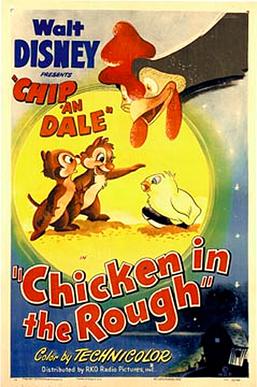
Chicken in the Rough is a 1951 animated short starring Chip 'n' Dale. It is Chip 'n' Dale's first solo cartoon together, and the footage is reused from the Silly Symphony short, Farmyard Symphony (1938). In the short film, Chip 'n' Dale wander into a farmyard to collect acorns. Dale mistakes an egg for a nut, but when he tries to demonstrate to a newly hatched chick how to get back into the egg, a rooster mistakes him for one of his chicks, much to Chip's amusement.
